|
||||||||||
|
|
||||||||||
|
||||||||||
|
|
||||||||||
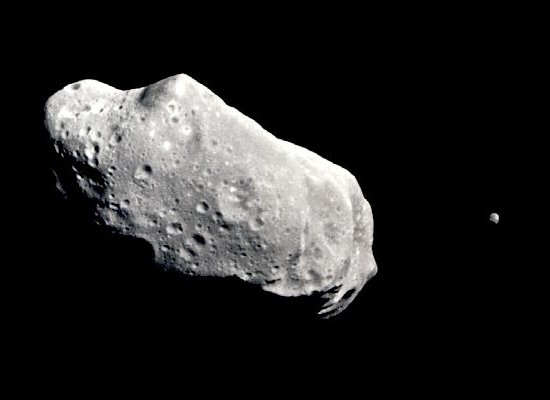
There are many types of objects in the solar system that can and do regularly impact the Earth. Most of these objects are small particles of rock or dust left behind by comets or created by collisions between asteroids. These small particles are collectively known as meteoroids. Meteoroids fall into Earth's atmosphere daily but pose no threat since they usually burn up at high altitude to create meteors. Those meteoroids large enough to survive their fall through the atmosphere and impact Earth's surface are called meteorites, but these objects are still too small to do any significant damage. It is estimated that about one hundred tons of interplanetary material falls to the surface of the Earth each day, but most of this debris consists of particles of dust that go unnoticed.
The greatest threat comes from asteroids and comets. Asteroids are bodies composed primarily of rock and metals left over after the planets and moons formed. Though still very small in comparison to Earth, they are much larger than meteoroids and are typically tens of meters to tens of kilometers in diameter. Most asteroids formed between Mars and Jupiter but their orbits are often perturbed by collisions or the gravitational influence of planets causing them to spiral inward closer to Earth. Comets are also fairly small bodies containing rock but mixed with large amounts of ice and gases. Comets formed at the outer fringes of the solar system but are sometimes perturbed from their orbits by collisions or the strong gravitation of giant planets like Jupiter. These disturbances cause comets to fall inward toward the Sun and they occasionally pass inside the orbit of Earth to pose a threat of impact.
Even relatively large objects like these do collide with Earth fairly regularly. It is estimated that an object with a diameter of at least 165 ft (50 m) hits Earth about once a century. The most recent major impact came in 1908 when an object struck a sparsely inhabited region of central Siberia. It is unknown whether the object was an asteroid or a comet, but the increasing pressure on the body as it plunged through the atmosphere apparently caused it to explode about 4 to 6 miles (6 to 10 km) above the Earth's surface. The energy of the detonation was estimated between 10 and 20 megatons of TNT, comparable to the largest nuclear weapons ever tested, and knocked down more than 80 million trees across an area of over 830 square miles (2,150 sq km).
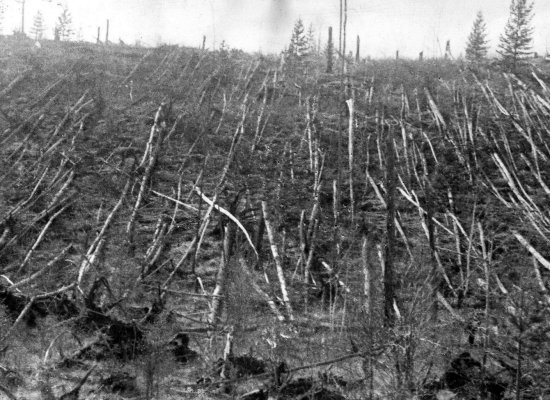
Megaton impacts like the 1908 Tunguska blast probably occur no more often than once a millennia, but smaller events happen more frequently. Gene Shoemaker estimated that an impact releasing as much energy as the atomic bomb dropped on Hiroshima, on the order of a few kilotons, occurs every year. Most of these detonations go unnoticed because they occur over the oceans, in uninhabited areas, or too high in the atmosphere to be seen from the ground. Although the public is generally unaware of such blasts, the US Air Force is capable of tracking them using early warning satellites designed to detect launches of nuclear missiles. The Air Force reported that 136 major explosions were detected in the upper atmosphere between 1975 and 1992.
A classification that has been devised for the most threatening asteroids is Potentially Hazardous Asteroids (PHAs). PHAs are selected based upon the object's potential to make a close approach to Earth and upon its size. Any asteroid that will never come closer to Earth than 0.05 astronomical units or is less than 500 ft (150 m) in diameter is excluded from the list of PHAs. Although an asteroid may be classified as a PHA, however, that does not mean that it will impact Earth but only that it has the potential to do so. These possible threats are regularly monitored to update their orbits and better quantify how dangerous they may be. To date, a total of 848 asteroids are considered PHAs.
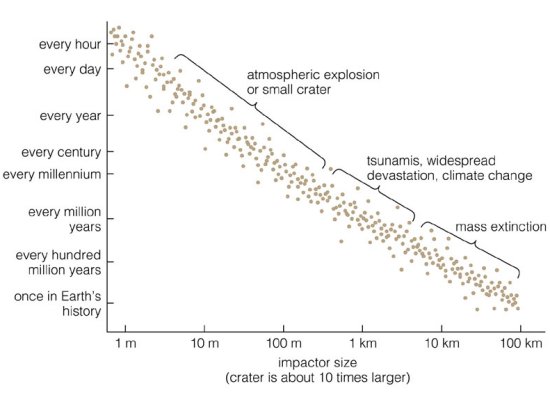
While I am not aware of any object predicted to strike Earth in 2018, many asteroids that will pass close to Earth have been discovered in recent years. The following list describes several discoveries that have been reported in the news because of some chance of impact. Any impact prediction includes a probability ranging from fairly high to extremely remote. Upon further investigation, all of the cases listed below have been classified as very unlikely to strike Earth any time within the next century. It is generally difficult for astronomers to make accurate predictions beyond 100 to 200 years because of uncertainties in many factors that define an asteroid's orbit, such as rotation rate, reflectivity of its surface, and the influence of other bodies it may encounter in the future.
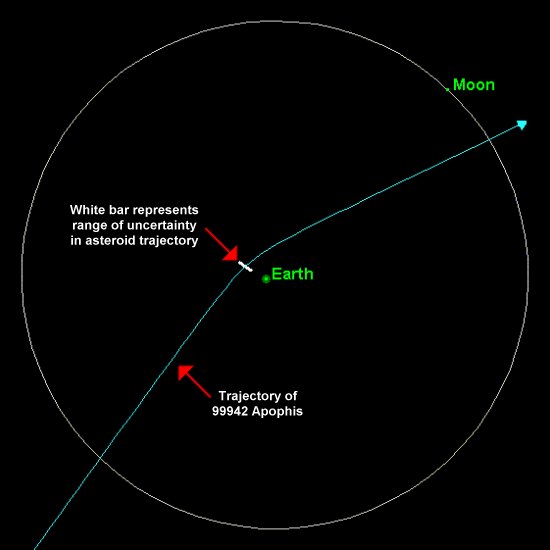
The threat becomes far more serious in the next tier covering index levels 5 through 7. Objects falling into this region are likely to make a very close approach to Earth and are large enough to do considerable damage should they impact. However, the probability of impact is unknown and further study is needed. Imminent collisions are classified at the most severe end the scale in indexes 8 through 10 ranging from localized destruction to regional destruction to a global catastrophe.
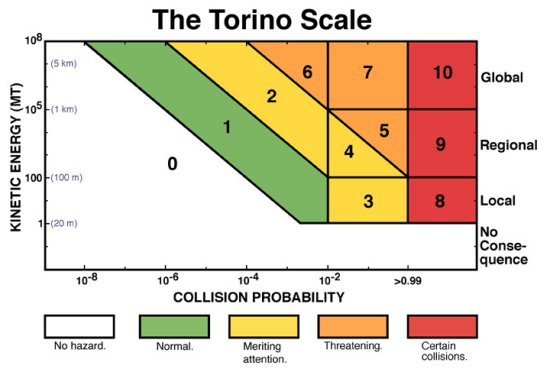
The objects currently being monitored by NASA are listed on the Near Earth Object Program website. As of this writing, none of the more than 100 objects listed are rated higher than 0 on the Torino scale and none has a probability of impact higher than about 1 in 1,000. The site explains that NASA uses an automated collision monitoring system called Sentry that scans the catalog of known asteroids and identifies those that could potentially impact Earth within the next century. Another useful page is the NEO Earth Close Approaches list including objects that have recently made or soon will make close approaches to Earth.
NASA's goal is to discover at least 90% of all Near Earth Objects with a diameter of at least 1 kilometer within 10 years. Several independent teams are funded to conduct this search. Among these are MIT's Lincoln Near-Earth Asteroid Research (LINEAR), Near-Earth Asteroid Tracking (NEAT) operated by NASA's Jet Propulsion Laboratory, Spacewatch at the University of Arizona, the Lowell Observatory Near-Earth Object Search (LONEOS), and the Catalina Sky Survey (CSS). Foreign participation also includes Australia's Siding Spring Survey (SSS), the Japanese Spaceguard Association (JSGA), and Italy's Asiago DLR Asteroid Survey (ADAS).
As of 1 March 2007, a total of 4,569 NEOs had been discovered. This total includes 64 comets and 4,505 asteroids. Of the asteroids, 707 are at least a kilometer in diameter. The total of Potentially Hazardous Asteroids (PHAs) is 839 while 134 of these have a diameter of a kilometer or more.
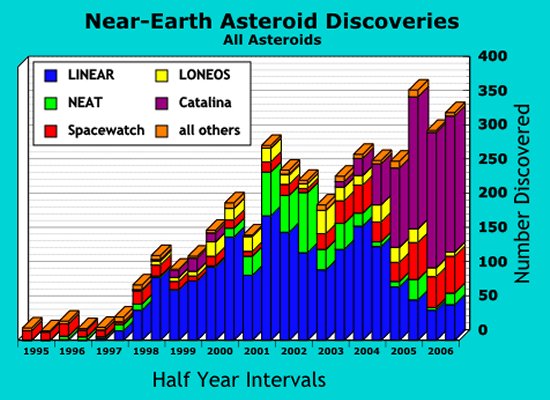
While there are currently no known objects posing an immediate threat of impact within at least the next 100 years, the question remains as to what could be done if an object on a collision course with Earth was found. Asteroid impacts are unique among natural disasters in that humans have the technological capability to prevent them from happening. Movies often portray dangerous missions using nuclear weapons to destroy these objects before they strike. The 1979 film Meteor, for example, depicts the US and USSR launching a swarm of nuclear missiles to destroy an asteroid headed for Earth. More recently, Deep Impact portrays a team of astronauts on a mission to plant a nuclear weapon within a comet on a collision course with Earth hoping to destroy the comet before it wipes out humanity. The same basic plot was recycled in the truly ridiculous Armageddon that replaces the comet with an "asteroid the size of Texas."
Unfortunately, these "action-packed, glued-to-your-seat blockbusters" are not very realistic. While detonating a nuclear device on or near an asteroid or comet might help nudge it out of Earth's path, the blast may do more harm than good. Research has suggested that the radiation created by a nuclear reaction can vaporize part of the surface of the object causing a layer of debris to blast off at high speed. This effect creates a thrust that deflects the object's course or slows it down slightly depending on where the blast is detonated. However, most scientists consider this kind of brute force approach a last resort. The greatest concern is that such an explosion might cause the asteroid or comet to break into multiple bodies. These fragments might still be on a collision course for Earth and would likely cause even more damage than the original body could.
There are many other more subtle methods of deflection that scientists prefer to nuclear detonations. Most of these approaches make use of natural phenomena that already influence the orbital trajectories of asteroids and comets. Collisions, for example, are often responsible for the paths asteroids and comets follow. It has been proposed that humans can simulate this effect by purposefully crashing sufficiently large spacecraft into the surface of an object to change its momentum. This approach is typically called a kinetic impact deflection. A related idea is to place a sufficiently massive spacecraft near an asteroid and use the mutual gravitational attraction between the two bodies to pull the asteroid into a non-threatening orbit. The primary disadvantage of these ideas is the large mass of the spacecraft needed to affect the orbit of an asteroid.
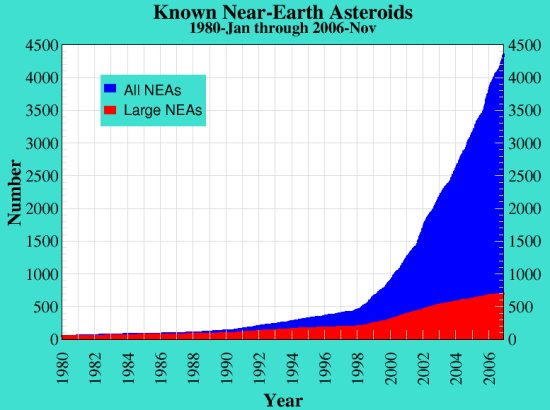
Another natural phenomenon that could be exploited is called the Yarkovsky effect. This effect says that the thermal heating of the Sun acting on a rotating object in space creates a small thrust. Over long periods of time, this thrust gently nudges the object along a different path. The effect is probably miniscule for asteroids over a kilometer in size, but it does have a significant influence on smaller objects. Should an asteroid on the order of a hundred meters or so be on a path that will impact Earth, scientists have proposed placing materials on the object's surface that would reflect or absorb heat. The different thermal properties would change the amount of thrust generated by its surface causing the body's orbital trajectory to gradually change. A similar idea is to use mirrors to focus solar energy onto the surface of a body to vaporize a small region and create a thrust like that of the Yarkovsky effect. Another suggestion is to attach a solar sail that takes advantage of pressure created by the solar wind to deflect the object.
Still other researchers propose more conventional methods of applying thrust to an object headed for Earth. Chemical rockets or electrical propulsion systems like those used on spacecraft today could be attached to an asteroid or comet and deflect its path. A more advanced idea is to attach a device called a mass driver to the object. A mass driver drills into the surface and ejects material away from the body to create a thrust effect.
The one factor common to any strategy for deflecting an oncoming asteroid or comet is time. It will take at least a decade to implement any of the approaches described above, which is why organizations like NASA have put so many resources into studying the space around Earth for objects that may pose a threat. The more warning time decision makers and engineers have, the smaller the nudge to change an object's path will need to be.
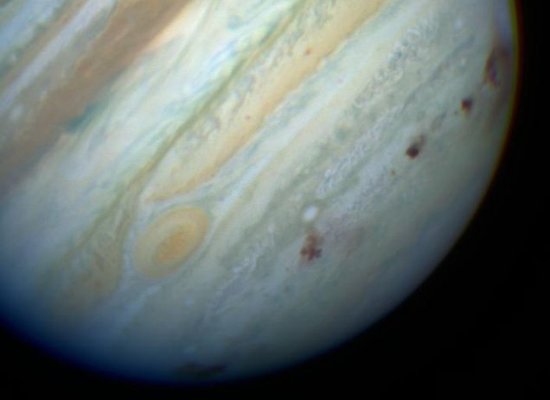
Though impacts from objects large enough to cause significant destruction are generally quite rare, perhaps a more immediate threat facing humanity instead comes from small rocks that vaporize high in the atmosphere. Had the object that struck Tunguska in 1908 instead hit Siberia 50 or 60 years later, it is likely that the Soviet Union would have thought is was under nuclear attack. In the tense days of the Cold War, the Soviets might have launched a full-scale retaliation on the West resulting in global nuclear devastation. Though diminished, that threat still exists today. It is believed that only the United States currently has the ability to differentiate between a man-made nuclear explosion in the atmosphere and a naturally occurring meteor detonation. If a sufficiently large meteor were to impact or explode above a major city or military base, it is very possible that the blast could be mistaken for a nuclear attack and provoke a retaliatory strike.
In January 2000, a meteor only 15 ft (5 m) across entered the atmosphere and exploded over the town of Whitehorse
in the Canadian Yukon. The blast created an electromagnetic pulse (EMP) similar to that of a high-altitude nuclear
detonation and disabled a third of the region's electrical power grid. This kind of high-altitude blast is
considered a likely first strike tactic that would blind a country's defenses to further attack or invasion. In
the summer of 2001, another high-altitude explosion was detected over the Mediterranean Sea. This detonation
produced a level of energy comparable to that of a nuclear weapon. In both cases, the US was able to determine
that the explosions were natural phenomena and not nuclear attacks. If the same events were to occur in a region
of world tension where countries possess nuclear weapons, the reactions of national leaders could have horrific
consequences.
- answer by Justine Whitman, 4 March 2007
Related Topics:
Read More Articles:


|
Aircraft | Design | Ask Us | Shop | Search |

|
|
| About Us | Contact Us | Copyright © 1997-2023 | |||
|
|
|||